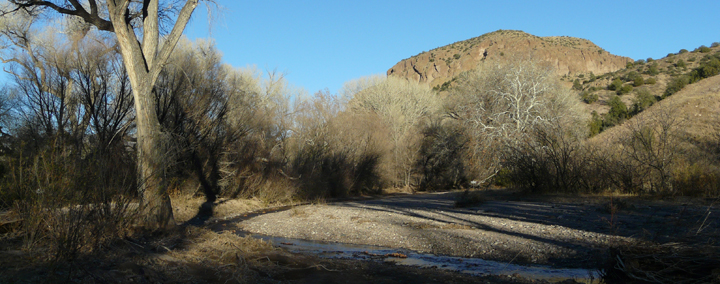THE MAGIC OF WINTER SOLSTICE LIGHT ON
BEAR CREEK IN SOUTHWEST NEW MEXICO
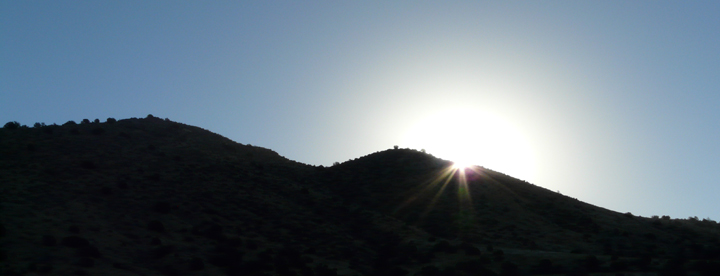
CYCLES OF SOLSTICE ON BEAR CREEK
Guests that return to Casitas de Gila Guesthouses at different times of the year will observe, while sitting in front of their Casita watching the Sunrise, that the Sun comes up at different places along the mountainous skyline above Bear Creek. In mid to late June the sun will pop up repeatedly and predictably for a few days from the same place behind Turtle Rock at the north end of the skyline. Then, as Summer fades and transitions into Early Fall, this anticipated shaft of Dawn’s first light begins its annual, steady, southward migration, arriving at the middle of the skyline in late September. Without pausing, the southward journey of Sunrise continues for another three months until late December, when it finally comes to its southern-most point of emergence near the top of South Peak. Then, after a few days respite when it will be seen to rise in the same place, this first light of Sunrise will begin once more to trace its six-month-long journey northward along the skyline to finally again emerge from behind Turtle Rock.
This observed seasonal progression of Sunrise is, of course, as most of us were taught so long ago, due to the annual, year-long cyclical progression of the Solstices, from Summer Solstice to Winter Solstice and then return. The Solstices, along with the Equinoxes, mark the passage of the Seasons and the progression of the Earth in its orbit around the Sun. Because the Earth’s axis of rotation is tilted at an angle of about 23.44° relative to its orbital plane about the Sun, the angle at which the Sun’s rays strike the earth varies as the Earth proceeds in its orbit. Hence, for a person who enjoys sipping tea every morning while waiting for Sunrise at the Casitas, over a year’s time, and about 46 gallons of tea, she or he will observe that the exact position of Sunrise will shift back and forth with the Seasons along the mountainous horizon to the East, covering a horizontal distance of about 0.8 of a mile between Turtle Rock and South Peak.

At Summer Solstice on either June 20 or 21 (the date varies with the year), the Northern Hemisphere’s rotational axis of the Earth is tilted most directly towards the Sun. As a result, this day has the greatest number of hours of daylight in the year, with the Sun at its highest point above the horizon overhead at noon and observed rising to the northeast, over Turtle Rock. On Winter Solstice, which falls on either December 21 or 22, the earth’s axis and the Casitas are now turned the farthest away from the Sun, resulting in the fewest hours of daylight of the year, with the Sun at its lowest point above the horizon at noon, and observed rising to the southeast, over South Peak.
THE MAGICAL LIGHT OF NEW MEXICO

Sunlight is magical in New Mexico. Its imprint upon the landscape and its inhabitants is sacred, legendary, and unique. To the ancient Native American Pueblo cultures of New Mexico, the Sun and its rays of life-giving and life-sustaining light were of central and sacred importance in their religion and cosmology, as so beautifully exemplified by the Zia Sun Symbol of the Zia Pueblo, which since 1924 has been honored as the central image in the New Mexico State Flag.
Indeed, it was the sight of the golden rays of the setting Sun illuminating the adobe walls of the Hawikuh Pueblo of the Zuni people in Northwestern New Mexico that convinced the Spanish priest Padre Marcos de Niza, on his expedition of 1539, that he had discovered one of the legendary Seven Cities of Gold of Cibola, leading to perhaps the most significant Spanish Expedition in the American Southwest. So convinced was he of this perceived wealth that upon his return to the Province of Nueva Galicia in what is now Northwest Mexico, his enthusiastic report inspired the Governor of New Galicia, Francisco Vasquez de Coronado, to assemble and lead the famed Coronado Expedition of 1540.
In more recent times, the unique light that permeates the New Mexican landscape has served as a visual magnet for artists and photographers for over 100 years. Beginning with the founding of the Taos Art Colony in 1902, and the Taos Society of Artists in 1915, New Mexico quickly became, and remains today, a mecca for some of the greatest talent of artists, photographers, and writers in the United States, including such luminaries as Georgia O’Keeffe and Ansel Adams, who have come to this land inspired by the intense light and color that inundates the unique landscape throughout the year.
EXPLORING THE UNIQUENESS OF NEW MEXICO LIGHT
There are several climatic, atmospheric, and terrestrial factors that combine to produce the unique light found in New Mexico. Primary and most important is the ubiquitous high-desert climate itself, characterized by predominately high barometric pressure, low humidity, and scant precipitation. Couple these factors with the extreme atmospheric clarity that results from the State’s small population and low levels of pollution, and the relatively thinner atmosphere, due to the general high elevation of the landscape, and the result is the distinctive turquoise blue New Mexican Summer sky that gradually takes on the deeper shades of cobalt blue seen in Winter. And it is because of this atmospheric clarity that the full spectrum of undiluted, non-refracted or non-degraded frequencies of sunlight are allowed to penetrate and illuminate the iconic New Mexican landscape with such intensity and brilliance.
THE INTENSE LIGHT AND SHADOW OF WINTER SOLSTICE
The perceived intensity and brilliance of the New Mexico Sun will also vary along with the seasons in response to the angle at which the Sun’s rays strike the earth due to the tilt of the Earth’s rotational axis. In the Summer, when the Sun traces its daily passage high overhead, the sunlight in New Mexico is virtually omnipresent – penetrating, bouncing, and reflecting soft, warm, glowing light into the shadows of even the deepest canyons and thickest mountain forests. With the coming of Fall, however, as the daily arc of the Sun’s passage traces ever lower towards the southern horizon, the intensity of the direct sunlight gradually decreases. And with this decrease, one notices that the soft warm glow once reflecting within the shadows of the canyons and forests takes on a harder, cooler, dimmer, bluish tone, and that the contrast between light and shadow has increased markedly. By Winter Solstice this transition is complete and the contrast between light and shadow reaches its maximum, so that while the actual intensity of the light is less at any given time of the day when compared with Summer, it seems just as bright because of the greater contrast with the darker shadows. One notices that with the passing of Winter Solstice there is no warmth in the shadows at all and that snow, frost, and frozen ground will remain in shadowed places day after day even though daytime temperatures may rise 20° or more above freezing.
A JOURNEY INTO WINTER SOLSTICE LIGHT ON BEAR CREEK

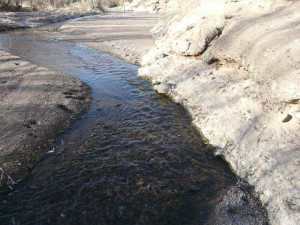
Morning Light
December 22, 2013, dawns high-pressure clear and in the mid-20s at Casitas de Gila, the low pressure and accompanying light snow of three days prior are now long gone, well on their way east to deliver a New England White Christmas. Looking up Bear Creek past half-shadowed Turtle Rock, the snow covered ramparts of the Pinos Altos Mountains in the Gila Wilderness glisten beneath low-hanging clouds in the chill morning light. Below, in the creek, the leafless cottonwoods stretch skyward for the morning light from the still-shadowed floodplain. It is an absolutely perfect day to explore and experience the brilliant morning light of a New Mexico Winter Solstice in Bear Creek Canyon.
Leaving the sun-drenched, east-facing Casitas behind, one descends the trail down the cliff-lined western slopes of the canyon to the creek bottom a hundred feet below. Reaching the bottom of the trail one sees that the morning light has also had just arrived at the base of the western slopes of the canyon. Bear Creek itself meanders in and out of the light. Starting at the south boundary fence of the Casita Nature Preserve in the early morning light, one begins a slow ramble upstream along the Bear Creek floodplain and adjacent forested stream terrace.
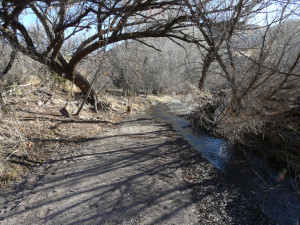
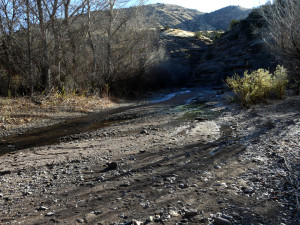
With the Solstice Sun still very low in the sky, the long shadows of the cottonwoods and willows bordering the creek criss-cross the floodplain producing a two-dimensional forest of trunks, branches, and twigs. Emerging into the light, the Creek blazes with swirling ripples of gold engulfing the even brighter, shining, gold-tinged boulders of white welded tuff. Walking at the water’s edge the silence is complete, broken only by the low murmurings of the creek and the crunching of the icy pinnacles of frost-heaved sand beneath one’s boots …
Approaching the deeply-shadowed cliffs, shallow frozen pools at the water’s edge offer crystalline windows into mosaics of entombed drab, brownish, and decaying cottonwood, willow and sycamore leaves, the microbial degradation of the leaves temporarily halted until once again revitalized by the Sun’s returning rays. Above the water’s edge, thick carpets of heavily-frosted leaves display a Winter Solstice kaleidoscope of texture and muted color.
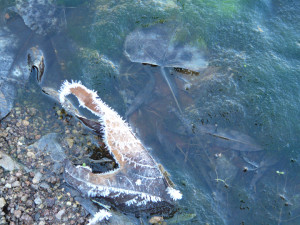
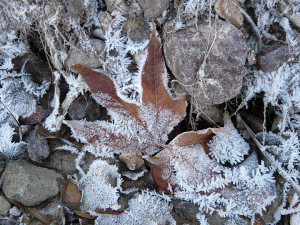

Continuing upstream, the Creek meanders slightly westward away from the cliffs, leaving the Creek in alternating patterns of light and shadow that change rapidly as the Sun arches ever higher above the cliffs. Leaving the Creek to walk the trails on the east side of the Creek one soon comes to the Big Cottonwood, where the quirky wrought iron bistro table and chairs wait in illuminated silence, the table thoughtfully set by Mother Nature with last night’s fallen leaves.
Eventually one arrives at the trail’s end at the northern end of the Casita land. Here the floodplain is much wider and more open. With Turtle Rock towering in the distance, but no sheer cliffs nearby to cast Bear Creek into shadow, this section of the creek receives perhaps twice as much Sun during the course of a Winter Day. As a result, one observes that the quiet pools are not frozen here and display more abundant signs of life and activity than seen down by the cliffs. Tiny minnows dart over the fallen leaves covering the bottom of the pools, and here and there numerous new small clumps of bright-green watercress are observed growing on top of the pools and eddies along the creek.
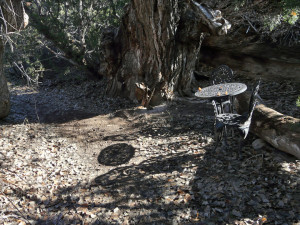
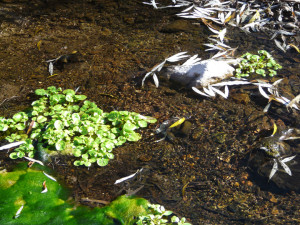
Late Afternoon Light
Some of us may remember, when as children playing outside just before sunset, the way our shadows lengthened, making us seem taller and taller as the sun slowly set in the West, and how we delighted in this phenomena as we ran home for dinner, flapping our arms in glee as we watched our shadows assume the dimensions of some giant bird.
Very few of us, however, probably ever noticed in those days the similar phenomena of how, at any given time of the day, our shadows would also grow progressively longer day by day as the Sun’s daily arc across the sky sank ever lower towards the southern horizon in its passage towards Winter Solstice.
The hilly western horizon behind the Casitas is 400 to 600 feet lower than the mountainous horizon on the other side of Bear Creek to the east of the Casitas between Turtle Rock and North and South Peaks. Consequently, the rays of the setting Winter Solstice Sun cast much longer, deeper, and higher-contrast shadows across the Casitas and down into Bear Creek Canyon than those of the morning Sunrise, because of the higher angle of the Sun when it eventually emerges on the eastern horizon about an hour after official local sunrise.
For some 15 years now, the ever-changing late afternoon play of light, shadow, and color upon the rocky crags of Turtle Rock and adjacent summits of North and South Peaks across from the Casitas has created a fascinating daily panorama of Nature’s magnificence for both guests and hosts alike. The visual effect and resulting mood imbued by this daily spectacle varies markedly with the season and the weather over the course of a year. However, for many it is during the Winter that the effect is most dramatic, when the air is the clearest and the Sun’s rays strike the Earth at their lowest angle, creating the greatest contrast between light and shadow.
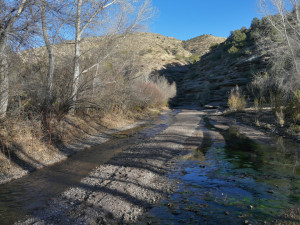
Having thought about these concepts for most of the day, it was with great anticipation that one quickly descended the trail from the Casitas to Bear Creek once more to observe, photograph, and compare the effects of the Late Afternoon Winter Solstice sunlight along the same route through the canyon that was taken earlier that morning. Having observed the Creek along the canyon bottom for over 15 years, one knew from previous photographic and painting excursions that the light and shadow of the late afternoon was typically more dramatic than that of the morning, but this was the first time that a direct comparison was made on the same day, and especially at Winter Solstice.
Arriving at the Canyon bottom about an hour before Sunset, the shadows cast from the young cottonwood trees along the western bank of the creek are already twice as long as the height of the trees that cast them, creating a ladder-like pattern of alternating light and dark contrast across the floodplain when facing upstream towards the deeply-shadowed cliffs below South Peak.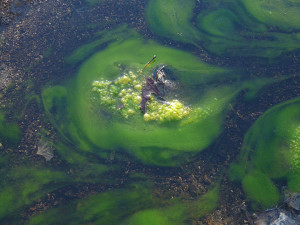 Current sculpted blue-green algae encapsulating a decayed sycamore leaf showing bubbles of oxygen produced from a Winter Solstice photosynthesis[/caption]
Current sculpted blue-green algae encapsulating a decayed sycamore leaf showing bubbles of oxygen produced from a Winter Solstice photosynthesis[/caption]
One observes that most of the frost and frozen pools seen during this morning’s hike have now disappeared; only a few icy patches remain along the cliffs where the Sun will not penetrate again for several weeks. Shallow frozen pools that only a few hours earlier entombed fallen leaves and comatose filamentous blue-green algae are now vibrant and alive, the slow moving currents sculpting irregular masses of blue-green algae into delicately festooned amoeba-like forms of bright yellowish green, delicately capped with shining bubbles of oxygen recently released from the day’s photosynthesis.
Further along, the creek flows up against vertical cliffs of layered conglomerate. Here the contrast between light and shadow reaches its maximum, the entire creek bottom now in deep shadow with the only source of visible light that of the rippling water reflecting the last of the retreating light high above at the top of the cliffs.
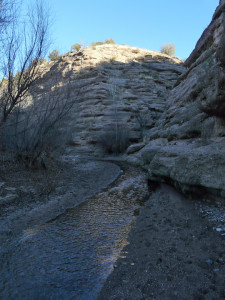
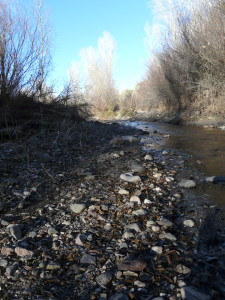
Continuing upstream not far beyond the chill of the shadowed cliffs one comes to a transition point where steadily advancing prongs of darkness penetrate and slowly envelop remaining patches of light. One pauses to watch in fascination as one by one shining rounded boulders of welded tuff are snuffed into darkness, and the young cottonwoods on the bank beyond appear to stretch higher in the remaining light as if in a futile attempt to escape the pending tendrils of darkness now swirling about at their roots.
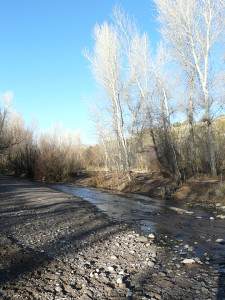
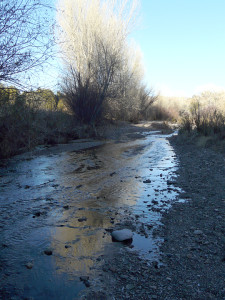
Bear Creek canyon widens below the Casitas, and in response the creek, now flowing along the deeply-shadowed western side of the canyon, spreads out laterally, its shallow depths masked by the reflections of the cobalt blue of the sky above and the yellow-tinged branches of the cottonwoods along the bank, still illuminated by the setting Sun.
At the northern end of the Casita Nature Preserve, Bear Creek flows through a heavily-vegetated floodplain where during times of high water or flash floods, such as during the Summer Monsoon Season, the floodwaters overflow the bank’s primary creek and spread across the floodplain to cut various secondary channels to carry the additional volume of water. After the flooding is over, most of these secondary channels are abandoned and dry up, except for occasional pools and small rivulets which may persist in them for months afterward. The ecology of this upper portion of the Casita Nature Preserve is highly diverse, varying from dense thickets of young trees and shrubs between the secondary channels to vaulted groves of very large, old-growth cottonwoods and occasional sycamore that attain heights of 120 feet or more on the bordering creek terraces. By the time one arrives at this area on the afternoon’s hike, the Sun is very close to setting behind the low hills in the west, creating a complex mosaic of contrasting light and shadow in all directions.
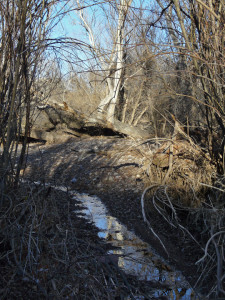
Upstream progress slows as one leaves the main channel to follow a meandering animal trail through a dense tangle of floodwater debris trapped in the maze of young new growth along one of the secondary channels. Much of this portion of the floodplain is dark now, with only the occasional shaft of intense brilliant sunlight piercing through the dense undergrowth to illuminate selected scenes in vignettes of incredible, magical beauty.
Leaving the thicket behind, another side channel with a larger flow of water is followed upstream. By now most of this channel is in complete shadow except for the periodic pools of reflected light that thwart the gathering darkness. The beauty of the pools is breathtaking, ranging from unbelievably brilliant, cobalt-blue reflections of the overhead sky set within a surrounding frame of reflected dark twigs and branches, to surrealistic pools of shimmering white and deep yellow where the reflected light from the uppermost branches of the still-lighted crowns of the old cottonwoods is splintered into a thousand points of light by the swirling waters of the rock-strewn creek. How fleeting it all is, and how fortunate one is to have passed this way!
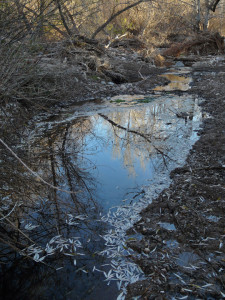
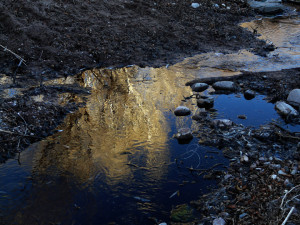
Diverting from the side channel, a short pathway leads up onto a sandy creek terrace where a grove of old-growth cottonwoods towers in stately silence. Here at the northern edge of the Casita Nature Preserve, one lingers a final moment in the deepening solitude, immersed in the magnificent view across the creek towards Turtle Rock before turning for home. The scene is entrancing and one of those that will live on in one’s mind for a lifetime, an incredible display of Light and Shadow on a Winter Solstice afternoon.
